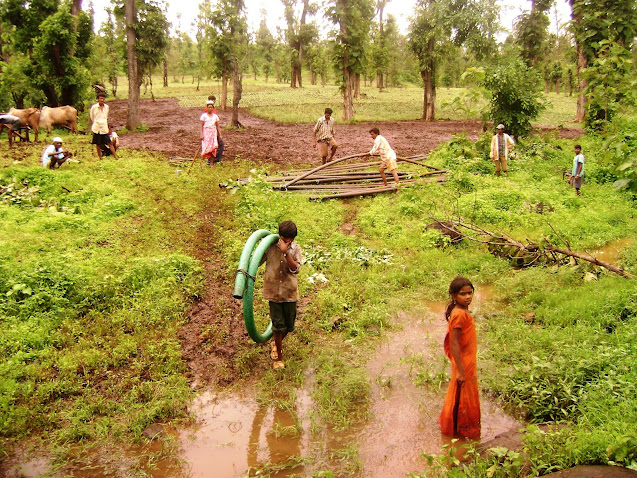Charming tribals of Dang
Two cute school children engaged in cleaning up their own school campus
It's no secret that the tribals are largely untouched by the rapid economic development witnessed elsewhere. However, they are rich in their hearts; one can feel their innocence just from their looks. Sometimes, it's difficult in the beginning to break ice with them because of the language and cultural barriers, but once you have won their hearts, they will do everything for you without asking anything in return.
The radio still is an important medium of entertainment among the people, though internet is slowly penetrating its way!
Tribals have a very simple lifestyle that includes fulfilling just basic things in life. I loved to observe them work in their fields. They would always appear to be nonchalant, carefree and happy, no matter what is going around in the economic and political scenes. The only things that matter to them are their small families, their meager needs like food, clothes and a small house. They do care about their forests a lot, especially the Mahua trees (Madhuca Longifolia) as they provide them their main source of pleasure- a country-liquor made from its flower, and the oil from its seeds. Sometimes, while visiting Dang, and interacting with the people, I pondered over the futility of all the economic activity that I am engaged in and stressing out in life! They are not quite saints, but they do possess, by default, all the wisdom of the saints.
Community farming practiced by the tribals of Dang
In the capitalist world full of cut-throat competition for economic benefits, they still believe in mutual cooperation. The picture above depicts a community-farming method. They typically choose a family's farmland to work on together, and then move on to the next one together, ensuring everyone's field is cultivated in time. Their main crop is Nagli (a minor millet grown in the area) though they have started growing more crops in recent times.
Some interesting facts about the tribals of Dang:
- There are about five Bhil Kings- Gadhavi, Pimpri, Amala-Linga, Vasurana, and Daher who protect the land of Dang
- They have never been conquered; not by Mughals, not by Marathas, not even by the mighty British!
- The British Army lost a war against them, and signed a treaty in 1842 to pay them an annual sum of money in order to use their forest resources
- The British, in order to appease the triabl kings, came up with an annual celebration called Dang Darbar to honour the Kings; this practice still continues to this date
- Dang Darbar is held every year just before the festival of colours, Holi during March- April
- During the festival, the Kings receive their annual payout, then from the British and now from the Government of India
- During this annual festivity, one can witness the colourful cultural heritage of the Dangi people- dance, music, food, etc.
- The five Dangi Kings are the only hereditary Royalties who are recognized by the Government of India till now (as the treaty was signed by the British, the GoI doesn't have the authority to withdraw it)
Tribal farmers engaged in transplanting the nagli plants (a minor millet)
Travel Tips:
Best Time: Between July and March
- July to September, during monsoon (rainy season), Dang looks in its pristine glory; the Saputara (hill station) Monsoon Festival is held sometime in August every year
- Dang Darbar Festival is held just before Holi in March or early April; look for the date
- April to June are difficult times because of high temperatures
How to reach Ahwa, the district HQ:
- Nearest airport: Surat (140 kms away)
- Nearest railway station: Waghai in (Dang); 80 kms away from Valsad
- Well connected by buses from south and central Gujarat
Where to stay:
- Good hotels and resorts are in Saputara, a hill station in Dang
- Ahwa has some decent options as well
The developmental dilemma:
I was fortunate to have the opportunity of traveling to Dang dozens of times during my professional times in Gujarat between 2006 and 2015. I was working with the Government of Gujarat; on a typical visit, I would stay there for 2-3 days for works relating to natural resources management. This gave me an opportunity to work closely with the communities, and know them from close quarters.
There is always a dilemma to choose between economic development and preserving the cultural ethos of the tribal communities. With the so-called development, comes the social and political problems of modern times. All of humanity has passed through various phases of economic development; at some point of time, every developed society would have seen such times as these tribal are in today. So, they seem to be naturally destined to reach the developed stage that rest of the world is now. However, in some corner of my heart, I wish if they could reach the so-called 'developed' stage without its downsides!
* Pictures were taken between 2009 and and 2015








Wonderful post and really interesting facts about tribals of the region.
ReplyDelete